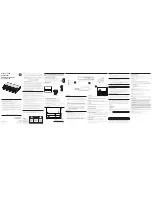
15
Chapter 4 Troubleshooting
This section provides solutions to problems usually encountered during the installation and operation
of this Wireless USB Adaptor. Read the description below to solve your problems.
What is the IEEE 802.11b standard?
The IEEE 802.11b Wireless LAN standards subcommittee, which is formulating a standard for
the industry. The objective is to enable wireless LAN hardware from different manufactures to
communicate.
What IEEE 802.11 feature are supported?
The product supports the following IEEE 802.11 functions:
•
CSMA/CA plus Acknowledge protocol
•
Multi-Channel Roaming
•
Automatic Rate Selection
•
RTS/CTS feature
•
Fragmentation
•
Power Management
What is Ad-hoc?
An Ad-hoc integrated wireless LAN is a group of computers, each with a WLAN adapter,
connected as an independent wireless LAN. Ad hoc wireless LAN is applicable at a
departmental scale for a branch or SOHO operation.
What is Infrastructure?
An integrated wireless and wireless and wired LAN is called an Infrastructure configuration.
Infrastructure is applicable to enterprise scale for wireless access to central database, or
wireless application for mobile workers.
What is BSS ID?
A specific Ad hoc LAN is called a Basic Service Set (BSS). Computers in a BSS must be
configured with the same BSS ID.
What is WEP?
WEP is Wired Equivalent Privacy, a data privacy mechanism based on a 40 or 104 bit shared
key algorithm, as described in the IEEE 802 .11 standard.
Can Wireless products support printer sharing?
Wireless products perform the same function as LAN products. Therefore, Wireless products
can work with Netware, Windows NT/2000/XP, or other LAN operating systems to support
printer or file sharing.
Would the information be intercepted while transmitting on air?
WLAN features two-fold protection in security. On the hardware side, as with Direct Sequence
Spread Spectrum technology, it has the inherent security feature of scrambling. On the
software side, WLAN series offer the encryption function (WEP) to enhance security and
Access Control. Users can set it up depending upon their needs.
What is DSSS? What is FHSS? And what are their differences?
Frequency-hopping spread-spectrum (FHSS) uses a narrowband carrier that changes
frequency in a pattern that is known to both transmitter and receiver. Properly synchronized,
the net effect is to maintain a single logical channel. To an unintended receiver, FHSS appears
to be short-duration impulse noise. Direct-sequence spread-spectrum (DSSS) generates a
redundant bit pattern for each bit to be transmitted. This bit pattern is called a chip (or chipping
code). The longer the chip, the greater the probability that the original data can be recovered.
Even if one or more bits in the chip are damaged during transmission, statistical techniques
embedded in the radio can recover the original data without-the need for retransmission. To an
unintended receiver, DSSS appears as low power wideband noise and is rejected (ignored) by
most narrowband receivers.
What is Spread Spectrum?
Spread Spectrum technology is a wideband radio frequency technique developed by the
military for use in reliable, secure, mission-critical communication systems. It is designed to
trade off bandwidth efficiency for reliability, integrity, and security. In other words, more
bandwidth is consumed than in the case of narrowband transmission
,
but the trade off
Содержание WL-U351
Страница 1: ...Wireless USB Adapter WL U351 User s Manual...


































